The Estimated Temperature of the Semiconductor Diode Junction on the Basis of the Remote Thermographic Measurement
Abstract
:1. Introduction
2. Materials and Methods
2.1. Measurement System
2.2. Simulations of Temperature Distribution in the TO-247 Case
for x = xk→T = T2
2.3. Image Processing in LabVIEW
3. Results
4. Discussion
5. Conclusions
Author Contributions
Funding
Institutional Review Board Statement
Informed Consent Statement
Data Availability Statement
Acknowledgments
Conflicts of Interest
References
- Abueed, M.; Athamenh, R.; Hamasha, S.; Suhling, J.; Lall, P. Effect of Fatigue on Individual SAC305 Solder Joints Reliability at Elevated Temperature. In Proceedings of the 19th IEEE Intersociety Conference on Thermal and Thermomechanical Phenomena in Electronic Systems (ITherm), Orlando, FL, USA, 21–23 July 2020; pp. 1043–1050. [Google Scholar] [CrossRef]
- Lu, W.-C.; Wu, C.-H.; Yeh, C.-Y.; Wu, C.-H.; Wang, C.-L.; Wang, L.A. D-Shaped Silicon-Cored Fibers as Platform to Build In-Line Schottky Photodetectors. IEEE Photonics Technol. Lett. 2021, 33, 317–320. [Google Scholar] [CrossRef]
- Otto, A.; Rzepka, S. Lifetime modelling of discrete power electronic devices for automotive applications. In Proceedings of the AmE 2019—Automotive Meets Electronics, 10th GMM-Symposium, Dortmund, Germany, 12–13 March 2019; pp. 1–6, ISBN 978-3-8007-4877-8. [Google Scholar]
- Steiner, A. 600 V CoolMOS™ P7. Infineon Technology AG, Munich, Germany, Infineon Appl. Note AN_201703_PL52_015. Available online: https://www.infineon.com/600v-p7 (accessed on 16 November 2022).
- Blackburn, D.L. Temperature measurements of semiconductor devices—A review. In Proceedings of the Twentieth Annual IEEE Semiconductor Thermal Measurement and Management Symposium (IEEE Cat. No.04CH37545), San Jose, CA, USA, 11–13 March 2004; pp. 70–80. [Google Scholar] [CrossRef]
- Plesca, A. Thermal Analysis of Power Semiconductor Device in Steady-State Conditions. Energies 2020, 13, 103. [Google Scholar] [CrossRef]
- Górecki, K.; Posobkiewicz, K. Cooling Systems of Power Semiconductor Devices—A Review. Energies 2022, 15, 4566. [Google Scholar] [CrossRef]
- Vellvehi, M.; Perpiñà, X.; Aviñó, O.; Ferrer, C.; Fusté, N.; Sánchez, D.; Jordà, X.; Godignon, P.; Massetti, S. Analysis of SiC Schottky diodes after thermal vacuum test by means of lock-in infrared thermography. In Proceedings of the 2020 21st International Conference on Thermal, Mechanical and Multi-Physics Simulation and Experiments in Microelectronics and Microsystems (EuroSimE), Cracow, Poland, 5–8 July 2020; pp. 1–6. [Google Scholar] [CrossRef]
- Kendig, D.; Tay, A.; Shakouri, A. Thermal analysis of advanced microelectronic devices using thermoreflectance thermography. In Proceedings of the 2016 22nd International Workshop on Thermal Investigations of ICs and Systems (THERMINIC), Budapest, Hungary, 21–23 September 2016; pp. 115–120. [Google Scholar] [CrossRef]
- Strąkowska, M.; De Mey, G.; Więcek, B. Comparison of the Fourier-Kirchhoff, Pennes and DPL thermal models of a single layer tissue. In Proceedings of the 15th Quantitative InfraRed Thermography Conference, Porto, Portugal, 20–23 September 2020; Available online: http://qirt.gel.ulaval.ca/archives/qirt2020/papers/127.pdf (accessed on 16 November 2022).
- Tzou, D.Y. Macro-to Microscale Heat Transfer: The Lagging Behavior, 2nd ed.; Wiley: Hoboken, NJ, USA, 2014; ISBN 978-1-118-81822-0. [Google Scholar]
- Feng, S.Z.; Cui, X.Y.; Li, G.Y. Transient thermal mechanical analyses using a face-based smoothed finite element method (FS-FEM). Int. J. Therm. Sci. 2013, 74, 95–103. [Google Scholar] [CrossRef]
- JESD 51-53. Available online: https://www.jedec.org/document_search?search_api_views_fulltext=13.%09JESD%2051-53 (accessed on 16 November 2022).
- JESD 51-14. Available online: https://www.jedec.org/document_search?search_api_views_fulltext=JESD%2051-14 (accessed on 16 November 2022).
- Hulewicz, A.; Dziarski, K.; Dombek, G. The Solution for the Thermographic Measurement of the Temperature of a Small Object. Sensors 2021, 21, 5000. [Google Scholar] [CrossRef] [PubMed]
- Zaccara, M.; Edelman, J.B.; Cardone, G. A general procedure for infrared thermography heat transfer measurements in hypersonic wind tunnels. Int. J. Heat Mass Transf. 2020, 163, 120419–120435. [Google Scholar] [CrossRef]
- Altenburg, S.J.; Straße, A.; Gumenyuk, A.; Maierhofer, C. In-situ monitoring of a laser metal deposition (LMD) process: Comparison of MWIR, SWIR and high-speed NIR thermography. Quant. InfraRed Thermogr. J. 2022, 19, 97–114. [Google Scholar] [CrossRef]
- Yoon, S.T.; Park, J.C. An experimental study on the evaluation of temperature uniformity on the surface of a blackbody using infrared cameras. Quant. InfraRed Thermogr. J. 2021, 19, 172–186. [Google Scholar] [CrossRef]
- Schuss, C.; Remes, K.; Leppänen, K.; Saarela, J.; Fabritius, T.; Eichberger, B.; Rahkonen, T. Detecting Defects in Photovoltaic Cells and Panels with the Help of Time-Resolved Thermography under Outdoor Environmental Conditions. In Proceedings of the 2020 IEEE International Instrumentation and Measurement Technology Conference (I2MTC), Dubrovnik, Croatia, 25–28 May 2020; pp. 1–6. [Google Scholar] [CrossRef]
- Chakraborty, B.; Sinha, B.K. Process-integrated steel ladle monitoring, based on infrared imagin—A robust approach to avoid ladle breakout. Quant. InfraRed Thermogr. J. 2020, 17, 169–191. [Google Scholar] [CrossRef]
- Tomoyuki, T. Coaxiality Evaluation of Coaxial Imaging System with Concentric Silicon–Glass Hybrid Lens for Thermal and Color Imaging. Sensors 2020, 20, 5753. [Google Scholar] [CrossRef]
- Wollack, J.E.; Cataldo, G.; Miller, K.H.; Quijada, A.M. Infrared properties of high-purity silicon. Opt. Lett. 2020, 45, 4935–4938. [Google Scholar] [CrossRef]
- Singh, J.; Arora, A.S. Effectiveness of active dynamic and passive thermography in the detection of maxillary sinusitis. Quant. InfraRed Thermogr. J. 2020, 18, 213–225. [Google Scholar] [CrossRef]
- Litwa, M. Influence of Angle of View on Temperature Measurements Using Thermovision Camera. IEEE Sens. J. 2010, 10, 1552–1554. [Google Scholar] [CrossRef]
- Dziarski, K.; Hulewicz, A.; Dombek, G. Lack of Thermogram Sharpness as Component of Thermographic Temperature Measurement Uncertainty Budget. Sensors 2021, 21, 4013. [Google Scholar] [CrossRef] [PubMed]
- View of TO 220 Case and TO 220 Case Dimension. Available online: https://www.onsemi.com/download/data-sheet/pdf/ffsh10120a-d.pdf (accessed on 16 November 2022).
- Toshiba. TO-247. Available online: https://toshiba.semicon-storage.com/ap-en/semiconductor/design-development/package/detail.TO-247.html (accessed on 16 November 2022).
- Cysewska-Sobusiak, A. Podstawy Metrologii i Inżynierii Pomiarowej; Wydawnictwo Politechniki Poznańskiej: Poznań, Poland, 2010. (In Polish) [Google Scholar]
- Krawiec, P.; Rózański, L.; Czarnecka-Komorowska, D.; Warguła, Ł. Evaluation of the Thermal Stability and Surface Characteristics of Thermoplastic Polyurethane V-Belt. Materials 2020, 7, 1502. [Google Scholar]
- Kawor, E.T.; Mattei, S. Emissivity measurements for nexel velvet coating 811-21 between 36 °C and 82 °C, 15 ECTP Proceedings. High Temp. High Press 1999, 31, 551–556. [Google Scholar] [CrossRef]
- Diselectric. Available online: https://www.distrelec.de/en/platinum-smd-temperature-sensor-pt1000-50-150-2mm-jumo-906125-pcs-1302-10-00/p/17668873 (accessed on 16 November 2022).
- Softronic. Available online: https://sofitronic.de/products_new2.asp?groups=Diode-TO247&gname=Diode-TO247&mname1=Diodes-Rectifier (accessed on 16 November 2022).
- Strąkowska, M.; Więcek, B.; De Mey, G. Identification of the Thermal Constants of the DPL Heat Transfer Model of a Single Layer Porous Material. Pomiary Autom. Robot. 2021, 25, 41–46. [Google Scholar] [CrossRef]
- Kopeć, M.; Więcek, B. AC temperature estimation of power electronic devices using 1D thermal modeling and IR thermography measurements. In Proceedings of the 15th Quantitative InfraRed Thermography Conference, Porto, Portugal, 20–23 September 2020; pp. 1–7. Available online: http://qirt.gel.ulaval.ca/archives/qirt2020/papers/161.pdf (accessed on 16 November 2022).
- Bejan, A. Heat Transfer; Wiley: New York, NY, USA, 1993. [Google Scholar]
- Alisibramulisi, A. Finite Element Analysis (FEA) Project in Structural Engineering Subject. In Proceedings of the 2019 IEEE 11th International Conference on Engineering Education (ICEED), Kanazawa, Japan, 6–7 November 2019. [Google Scholar]
- Devloo, P.R.B.; Bravo, C.M.A.A.; Rylo, E.C. Systematic and generic construction of shape functions for p-adaptive meshes of multidimensional finite elements. Comput. Methods Appl. Mech. Eng. 2009, 198, 1716–1725. [Google Scholar] [CrossRef]
- Ceric, H. Numerical Techniques in Modern TCAD. reposiTUm 2005, 102. Available online: https://repositum.tuwien.at/handle/20.500.12708/20403 (accessed on 16 November 2022).
- Li, B. Investigation and modelling of work roll temperature in induction heating by finite element method. J. South. Afr. Inst. Min. Metall. 2018, 118, 735–743. [Google Scholar] [CrossRef]
- Staton, D.A.; Cavagnino, A. Convection heat transfer and flow calculations suitable for electric machines thermal models. IEEE Trans. Ind. Electron. 2008, 55, 3509–3516. [Google Scholar] [CrossRef]
- Ghahfarokhi, P.S. Determination of Forced Convection Coefficient over a Flat Side of Coil. In Proceedings of the 2017 IEEE 58th International Scientific Conference on Power and Electrical Engineering of Riga Technical University (RTUCON), Riga, Latvia, 12–13 October 2017. [Google Scholar] [CrossRef]
- Aminu, Y.; Ballikaya, S. Thermal resistance analysis of trapezoidal concentrated photovoltaic–Thermoelectric systems. Energy Convers. Manag. 2021, 250, 114908. [Google Scholar] [CrossRef]
- IMAQ Vision for LabVIEW User Manual; October 2000 Edition, Part Number 322917A-01; National Instruments: Austin, TX, USA, 2000.
- IMAQ Vision Concepts Manual; June 2003 Edition, Part Number 322916B-01; National Instruments: Austin, TX, USA, 2003.
- Christopher, G.R. Image Acquisition and Processing with LabVIEW, 1st ed.; CRC Press: Boca Raton, FL, USA, 2003. [Google Scholar]
- Klinger, T. Image Processing with LabVIEW™ and IMAQ™ Vision; CRC Press: Boca Raton, FL, USA, 2003. [Google Scholar]
- User Manual UT51. Available online: https://www.manua.ls/uni-t/ut51/manual (accessed on 16 November 2022).
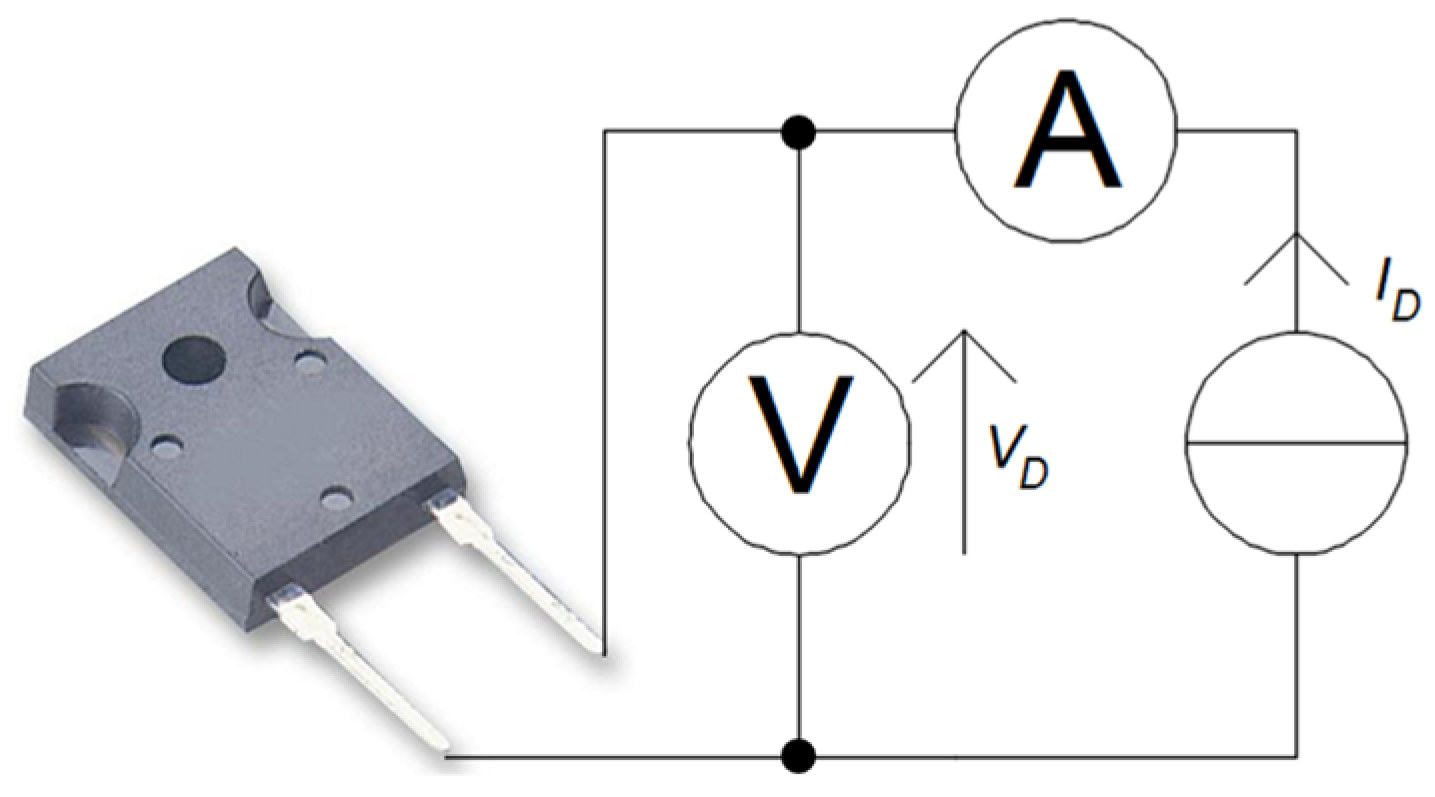

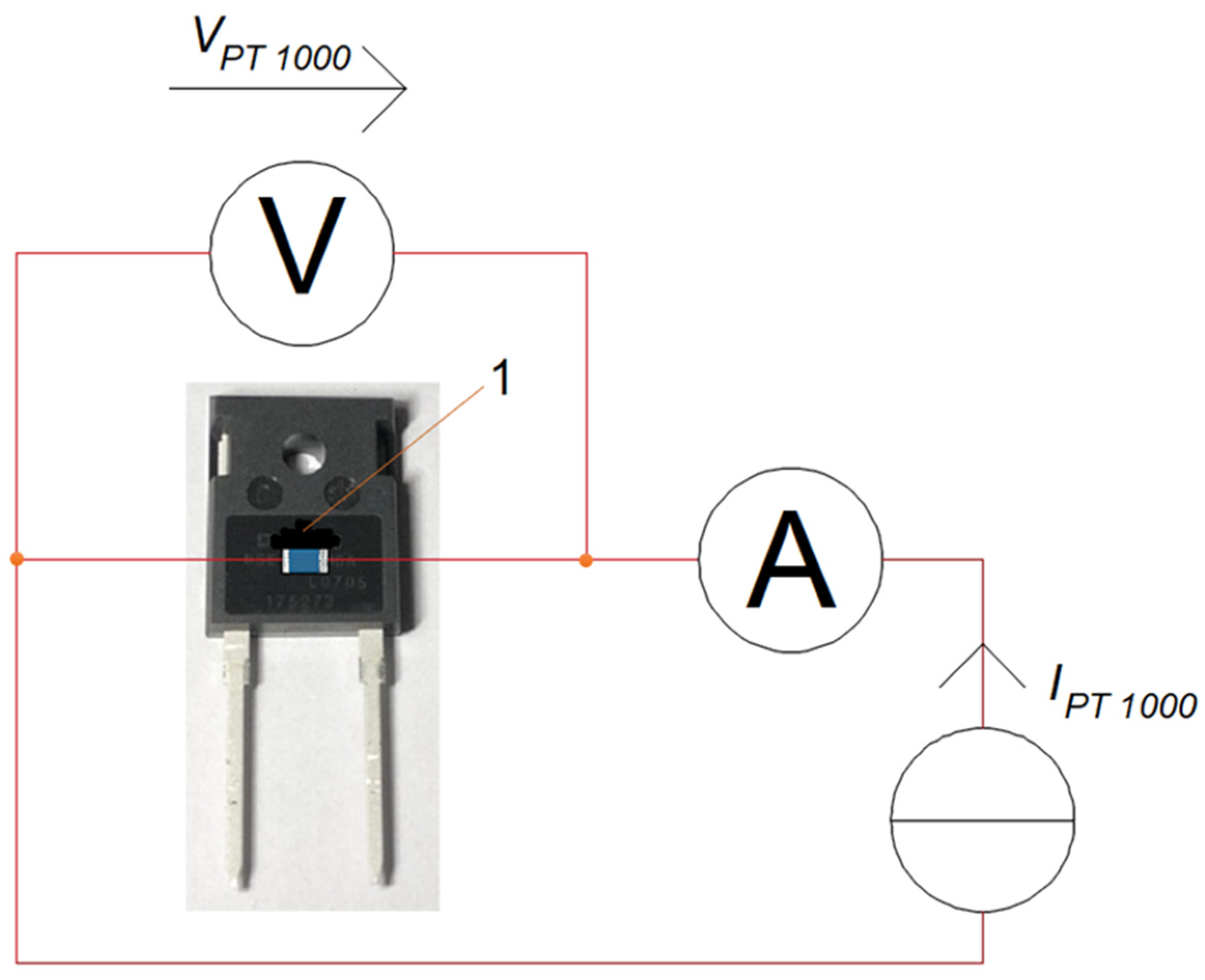


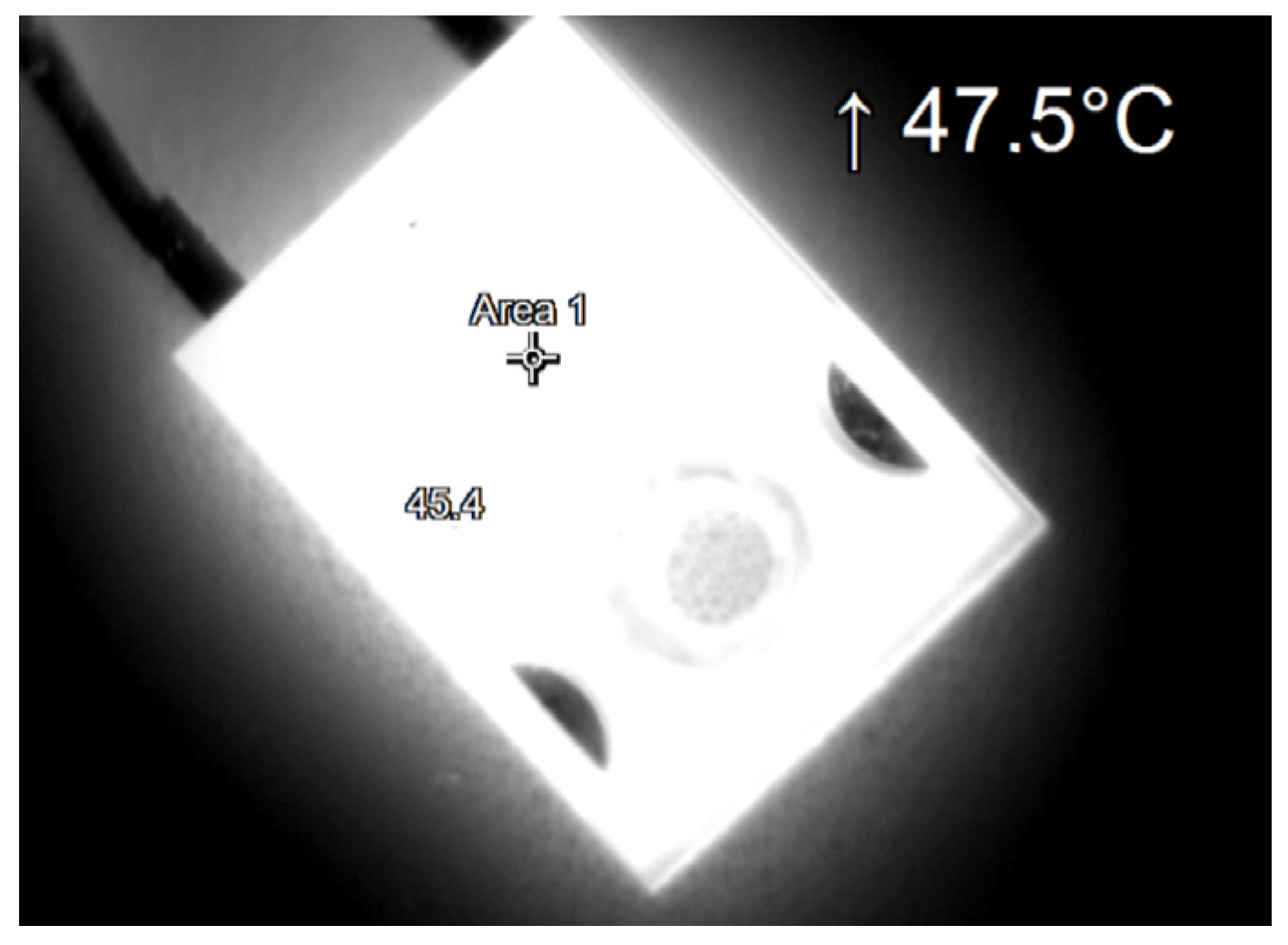
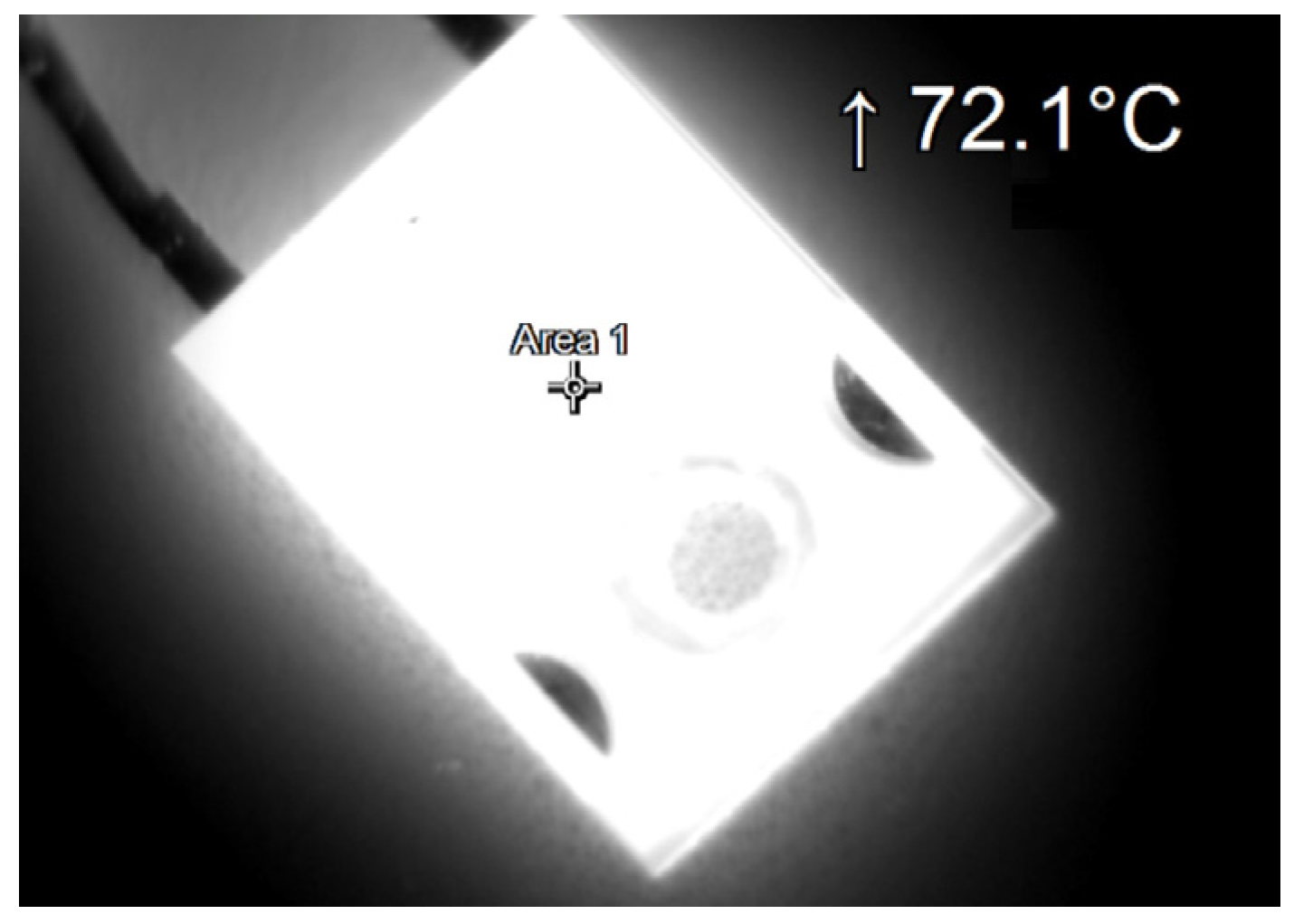

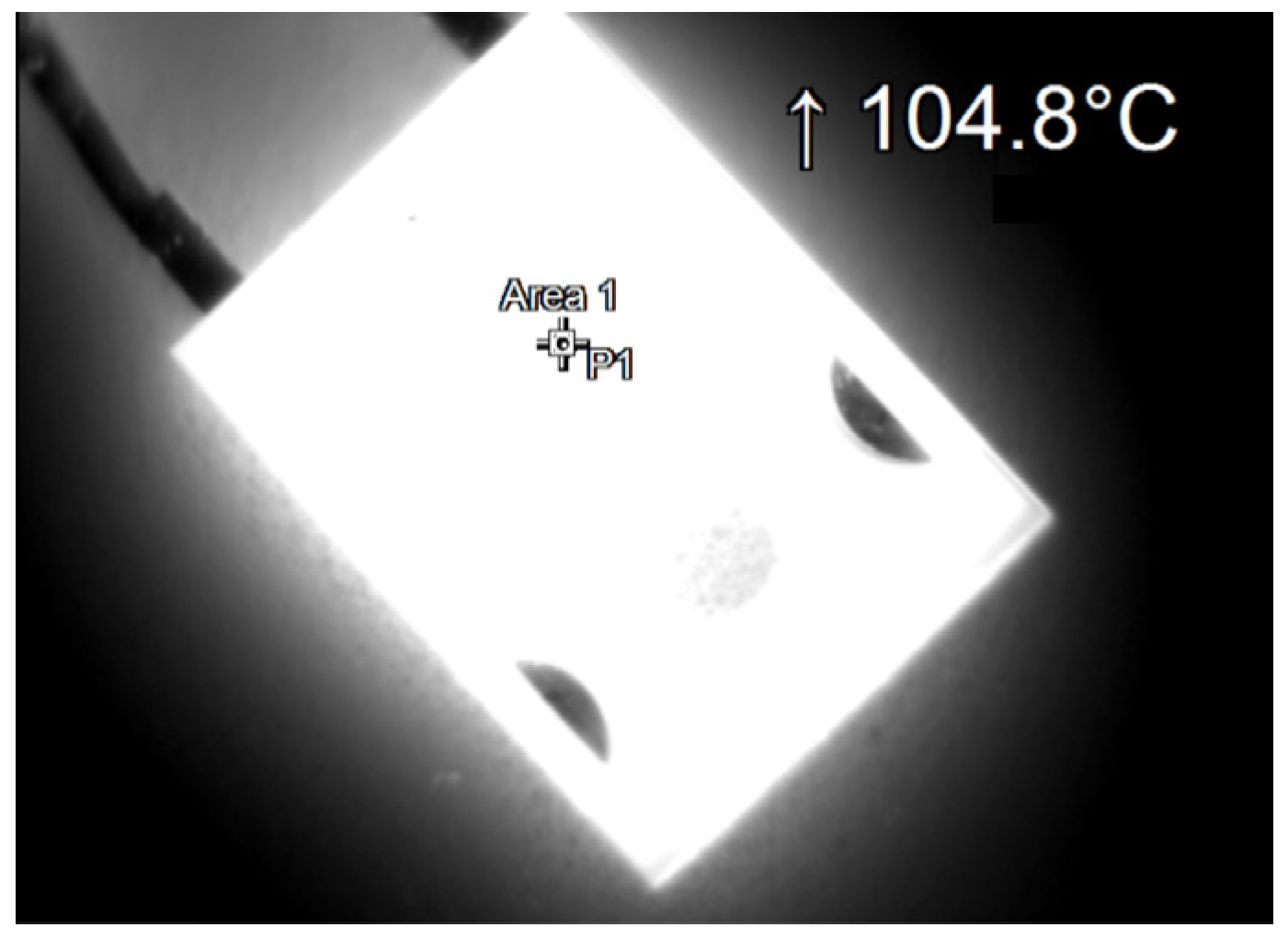
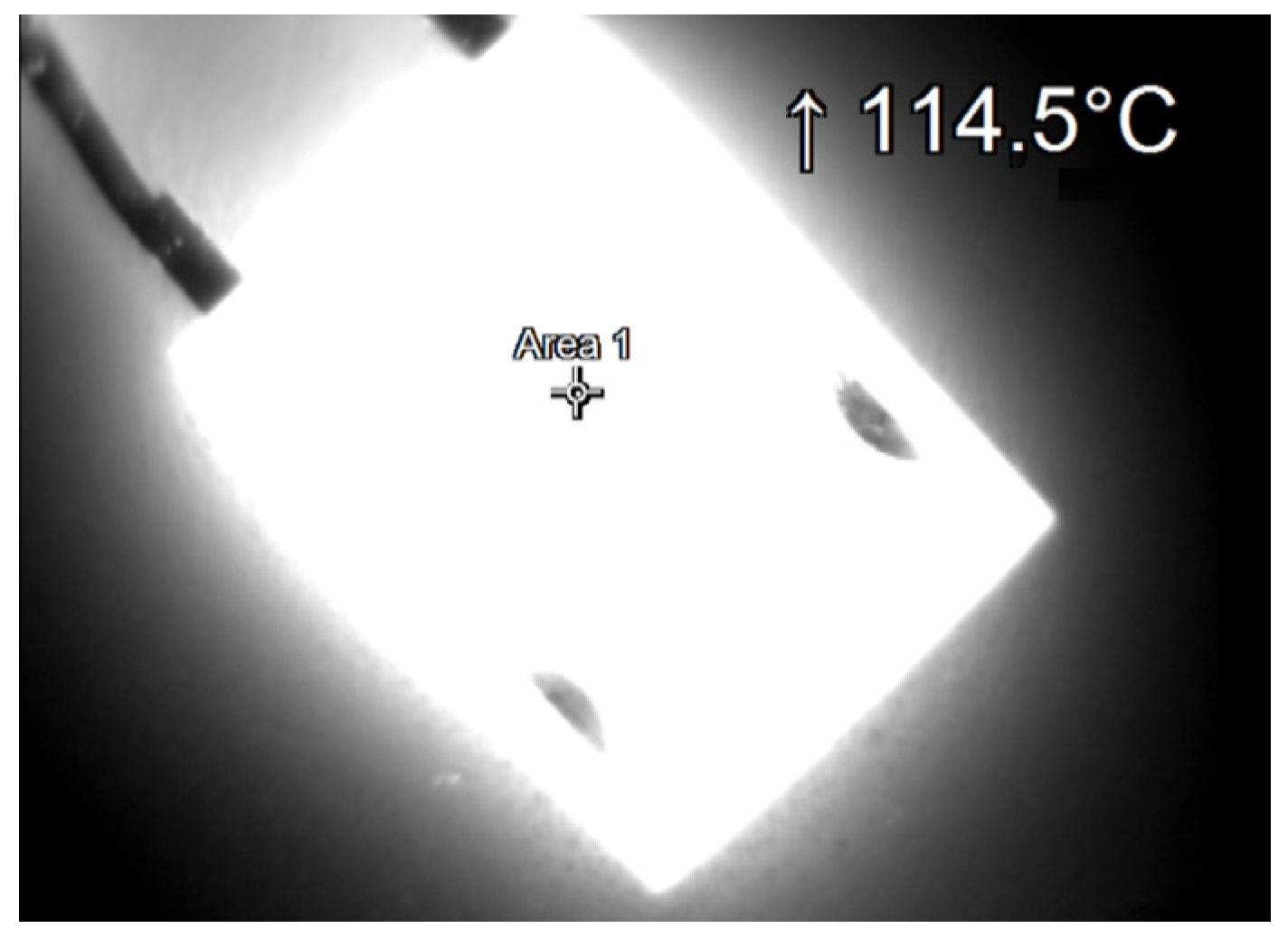
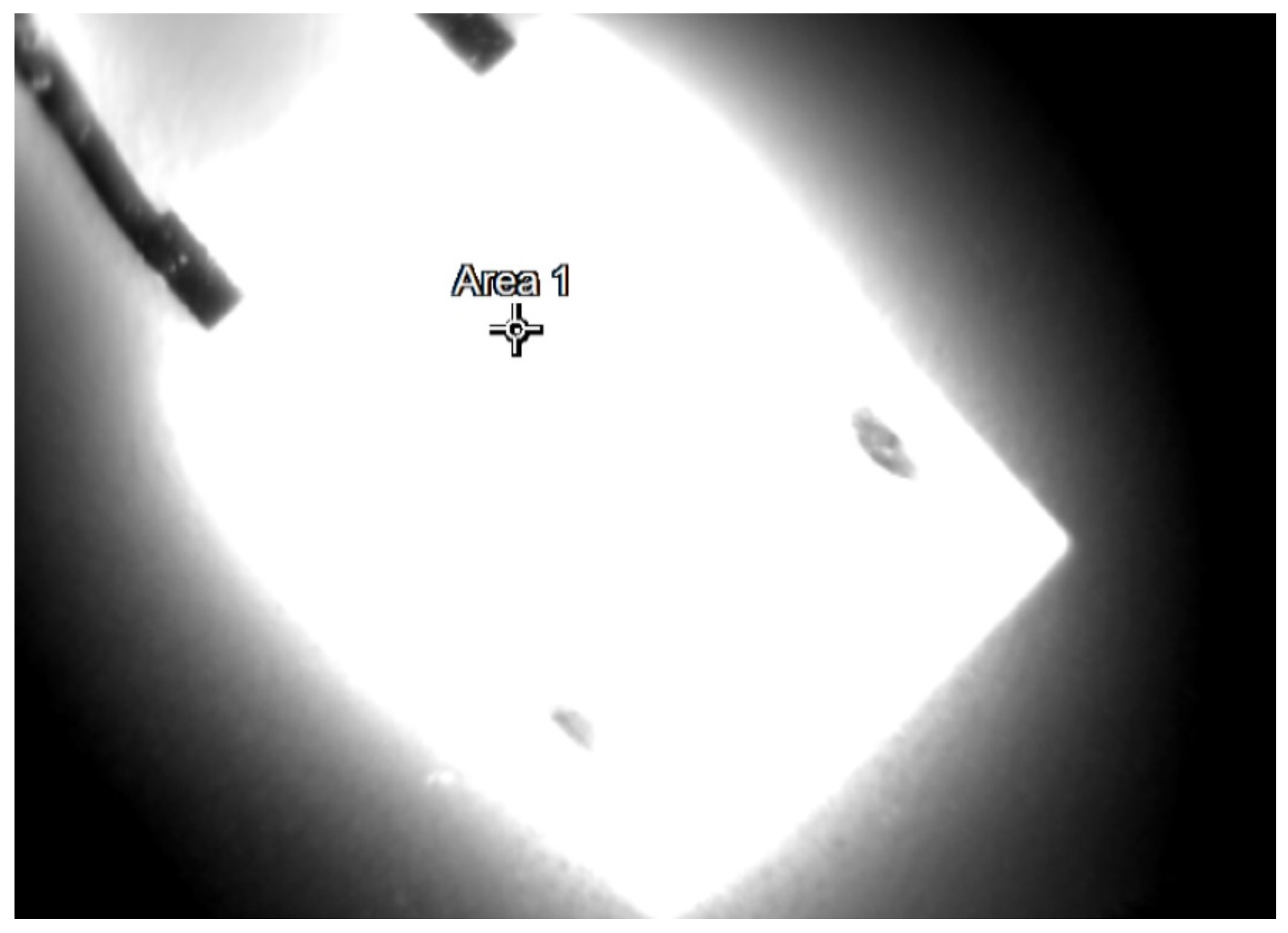
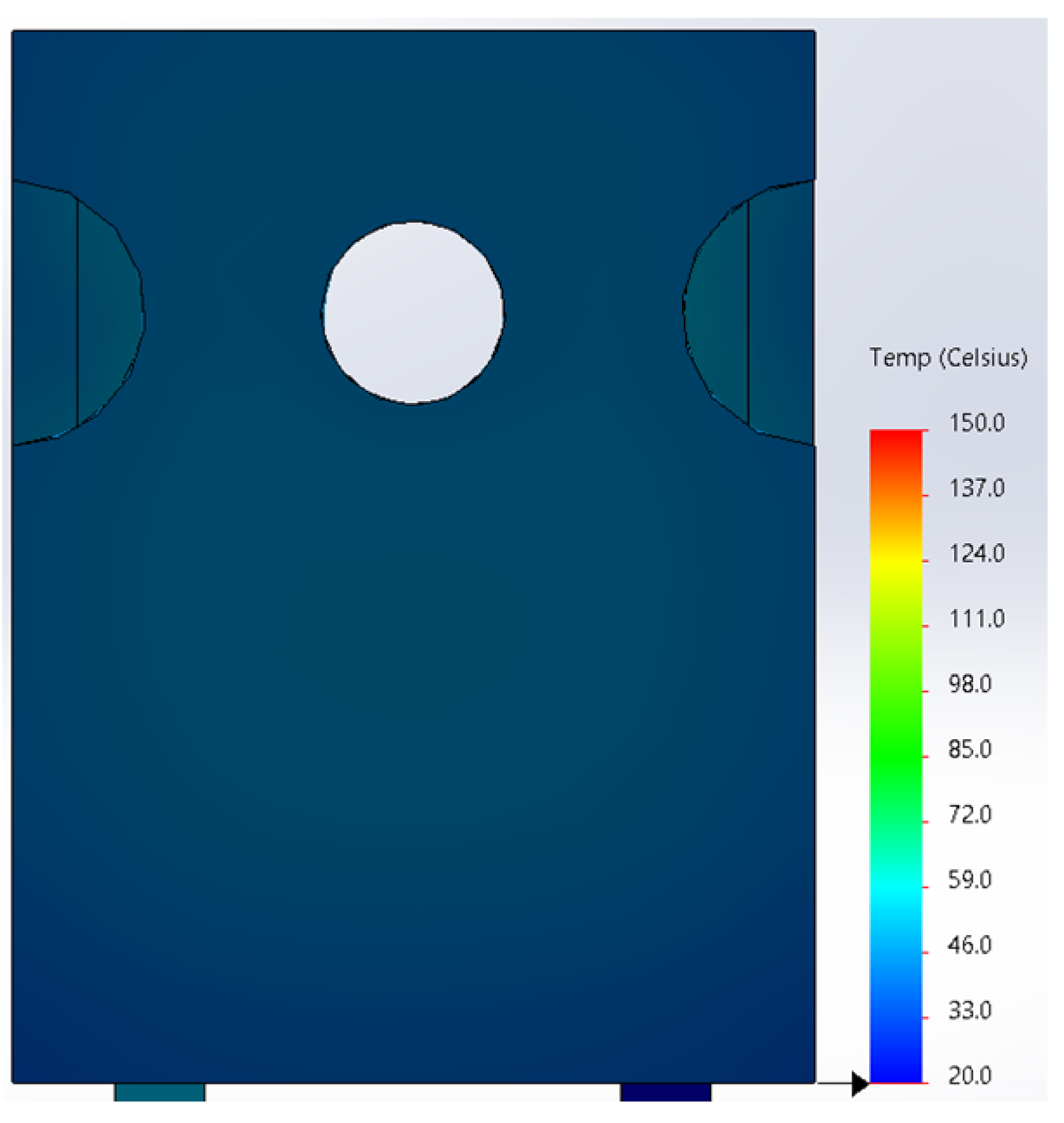
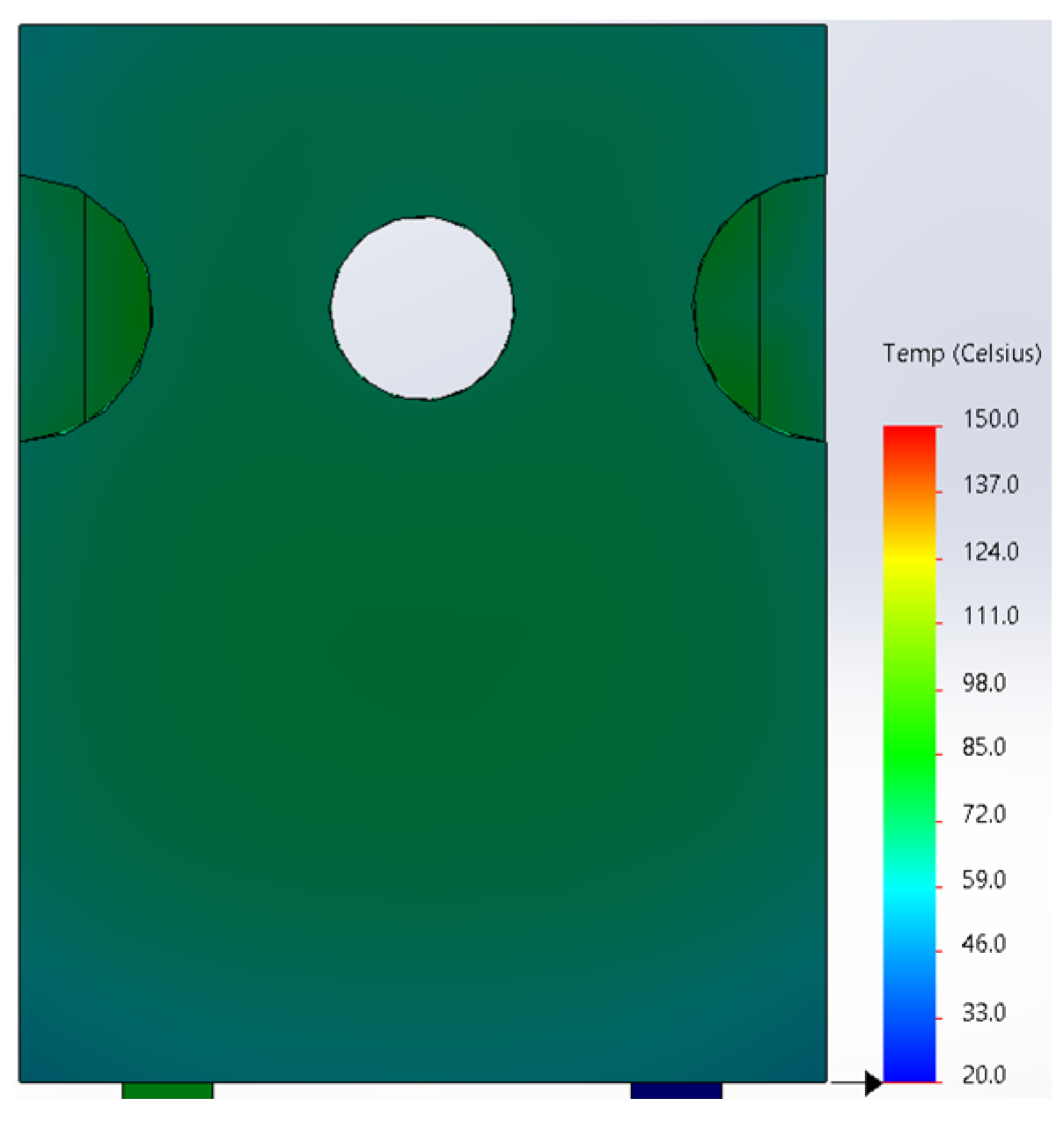
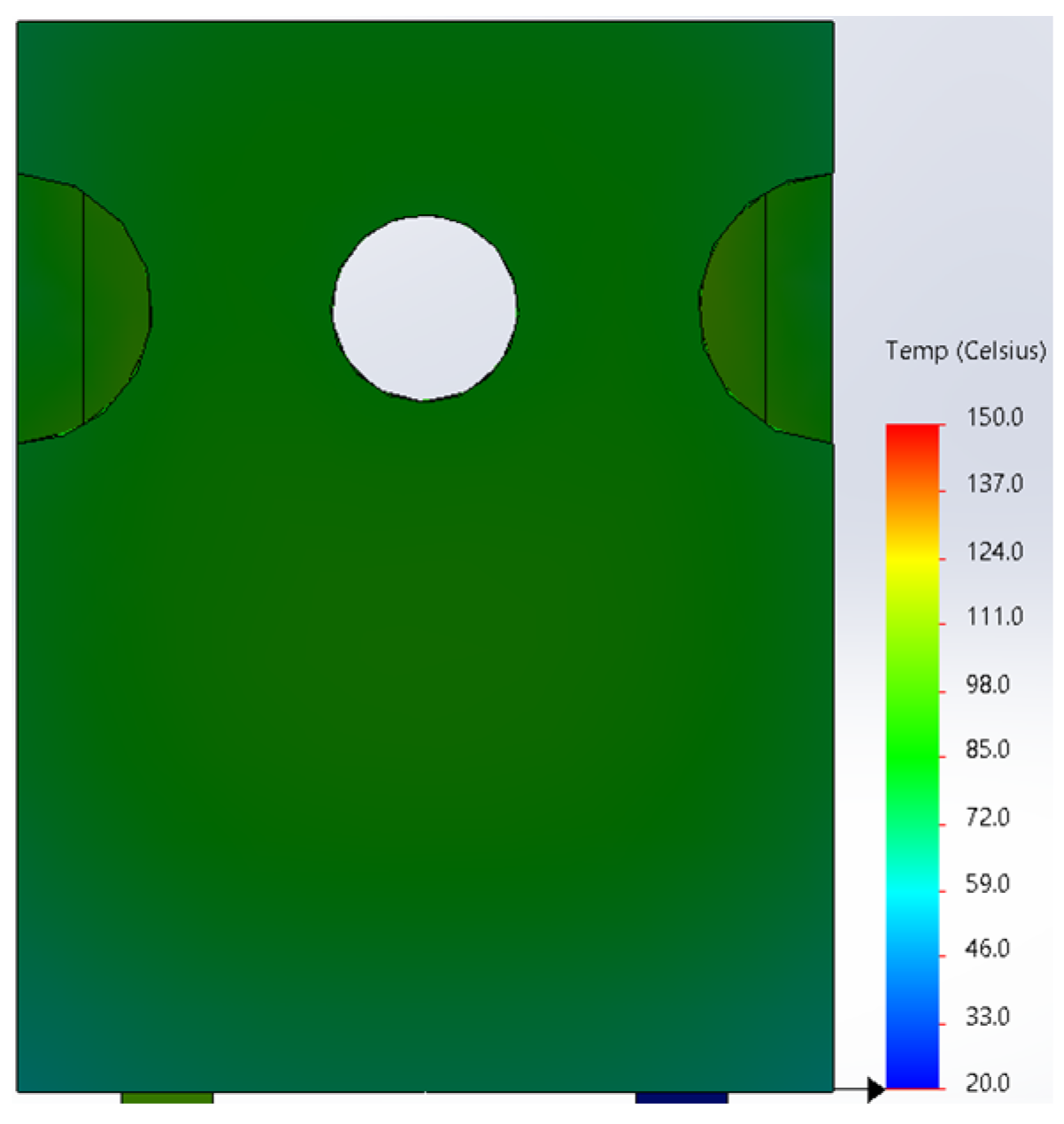
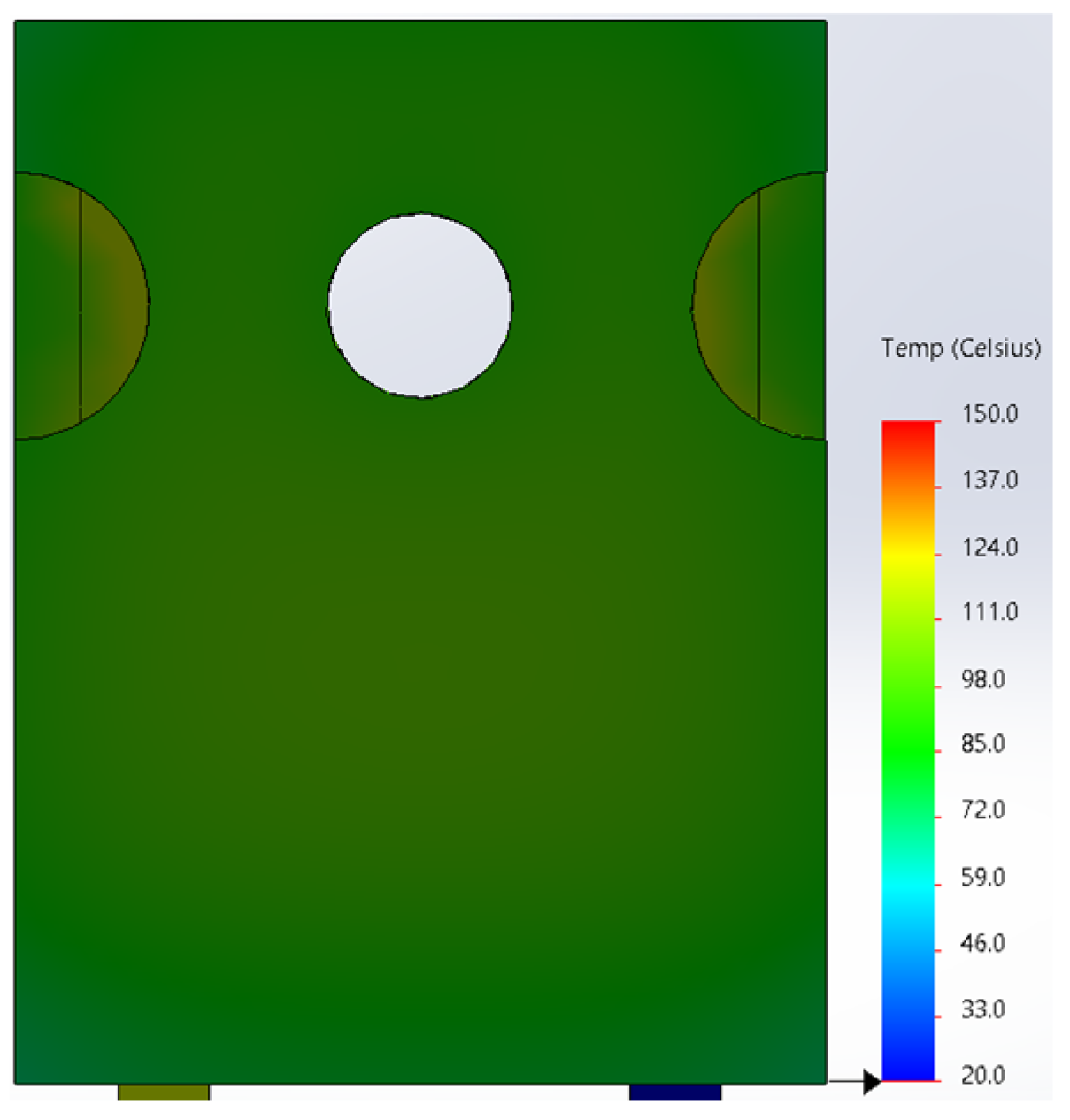
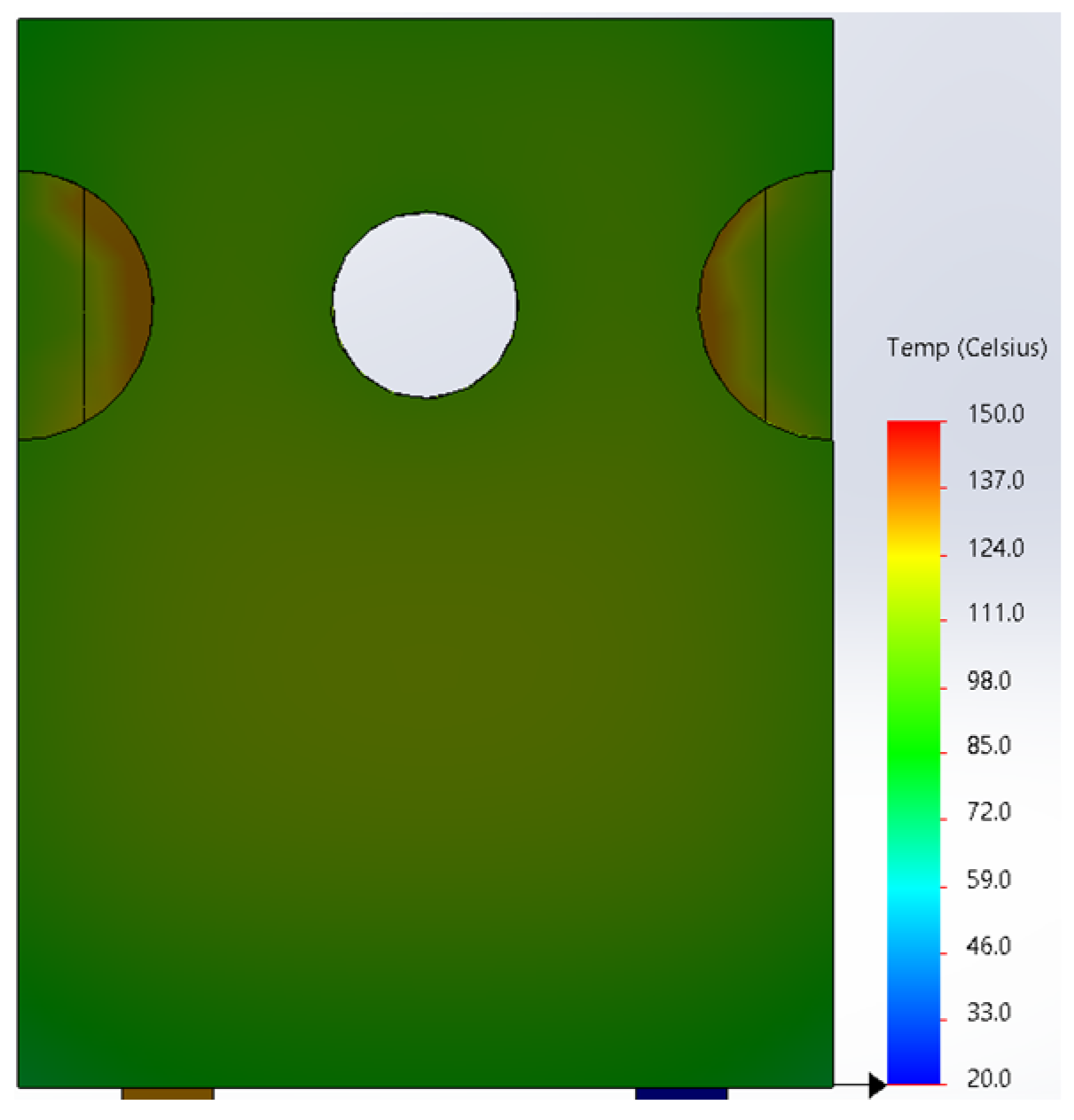
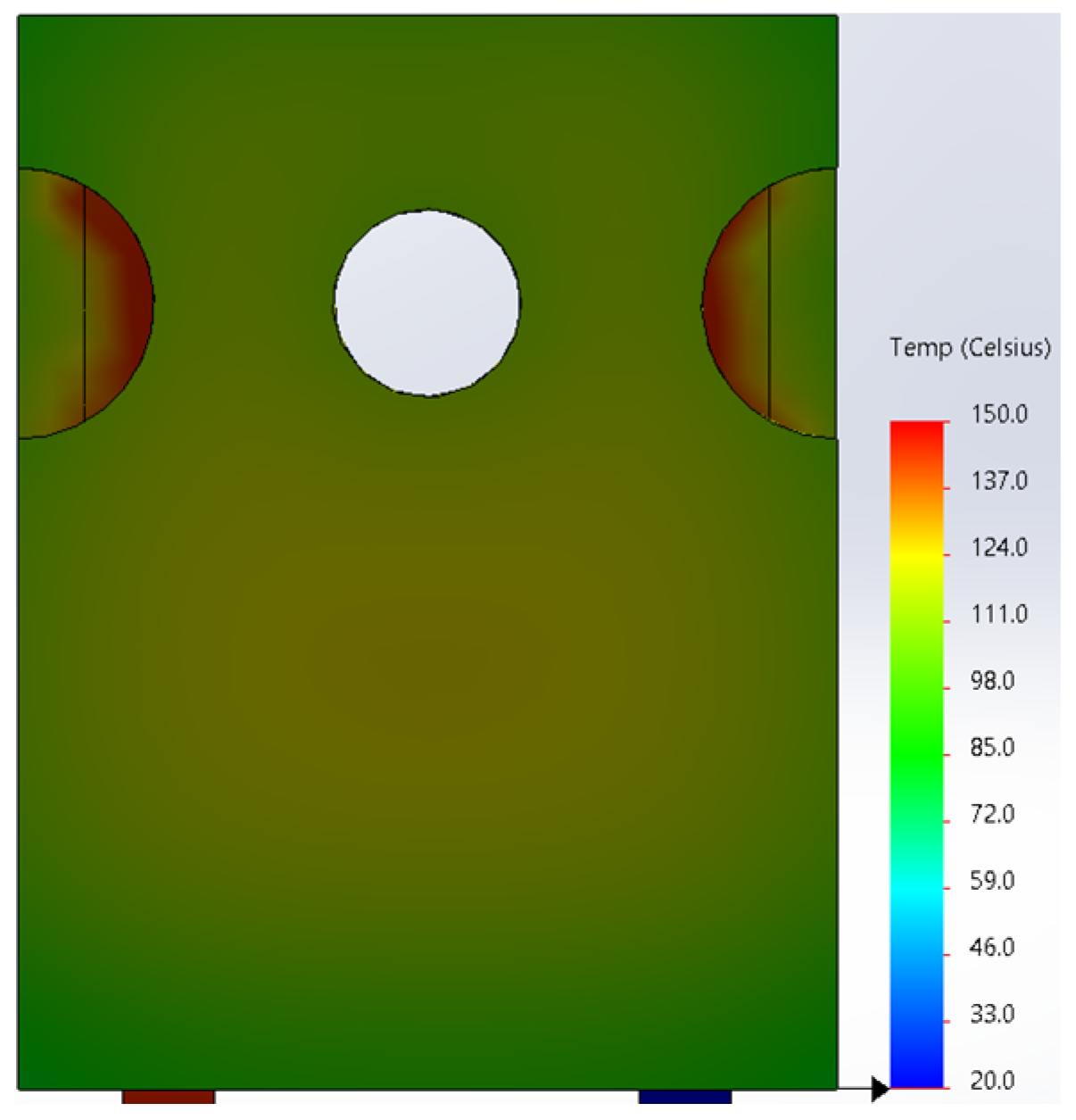
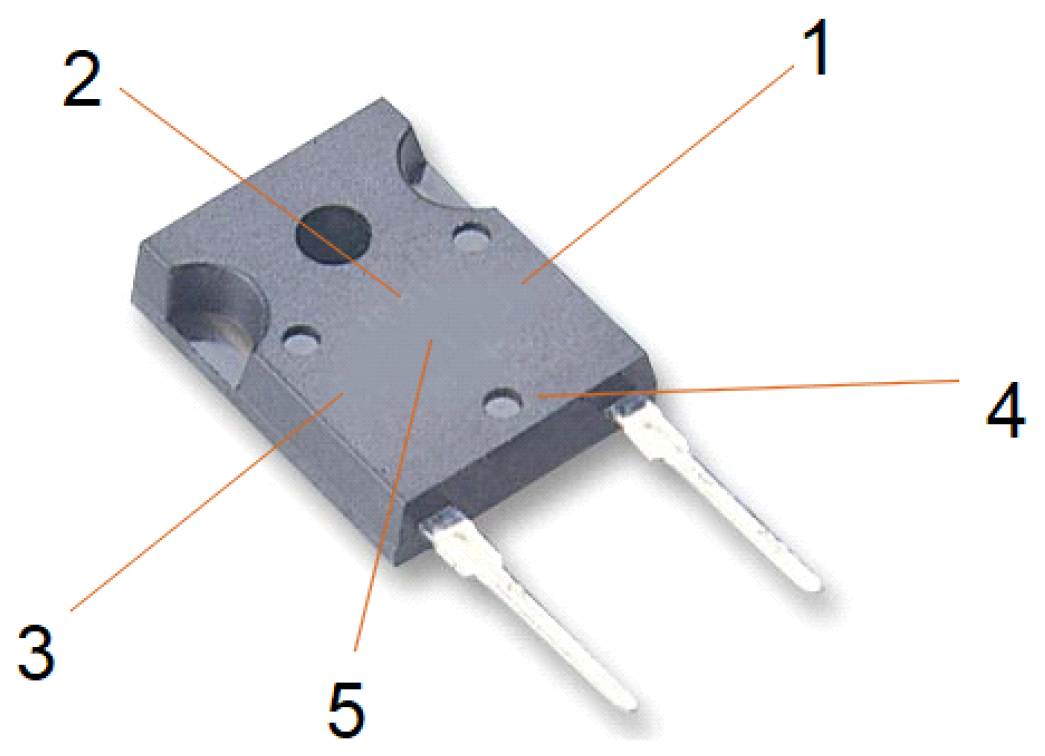
| Shape | Gr∙Pr | alam | blam | aturb | bturb |
|---|---|---|---|---|---|
| Vertical flat wall | 109 | 0.59 | 0.25 | 0.129 | 0.33 |
| Upper flat wall | 108 | 0.54 | 0.25 | 0.14 | 0.33 |
| Lower flat wall | 105 | 0.25 | 0.25 | NA | NA |
| Pj (W) | ID (A) | ΔID (A) | VD (V) | ΔVD (V) | ΔP (W) | ε (−) | hc (−) |
|---|---|---|---|---|---|---|---|
| 0.57 | 0.53 | 0.02 | 1.07 | 0.02 | 0.03 | 0.97 | 7,51 |
| 1.32 | 1.08 | 0.03 | 1.22 | 0.02 | 0.05 | 0.97 | 8.53 |
| 1.71 | 1.47 | 0.03 | 1.16 | 0.02 | 0.06 | 0.96 | 9.03 |
| 2.19 | 1.78 | 0.04 | 1.23 | 0.02 | 0.07 | 0.96 | 9.34 |
| 2.55 | 1.99 | 0.04 | 1.28 | 0.02 | 0.08 | 0.95 | 9.62 |
| 3.01 | 2.26 | 0.04 | 1.33 | 0.02 | 0.10 | 0.91 | 9.91 |
| Fragment of the Case | k (W/m·K) | The Material (−) |
|---|---|---|
| Mold body | 0.25 | The EMC material |
| The back of the case | 400.00 | Copper |
| The die | 150.00 | Silicon carbide |
| Leads | 400.00 | Copper |
| The material under the die | 400.00 | Copper |
| Point | 1 | 2 | 3 | 4 | 5 | |||||
|---|---|---|---|---|---|---|---|---|---|---|
| Pj (W) | TcT (°C) | TcS (°C) | TcT (°C) | TcS (°C) | TcT (°C) | TcS (°C) | TcT (°C) | TcS (°C) | TcT (°C) | TcS (°C) |
| 0.57 | 43.5 | 44.1 | 44.8 | 46.0 | 43.7 | 44.3 | 41.2 | 41.3 | 45.7 | 47.2 |
| 1.32 | 66.4 | 67.1 | 69.2 | 69.5 | 67.1 | 67.3 | 60.0 | 60.6 | 72.1 | 72.5 |
| 1.71 | 81.3 | 80.6 | 85.4 | 86.6 | 80.8 | 81.9 | 71.5 | 71.2 | 91.5 | 90.6 |
| 2.19 | 95.0 | 94.5 | 96.6 | 97.3 | 92.9 | 94.6 | 82.1 | 81.9 | 104.8 | 103.6 |
| 2.55 | 102.8 | 103.3 | 109.8 | 109.1 | 103.7 | 104.7 | 91.6 | 91.8 | 114.5 | 115.0 |
| 3.01 | 113.6 | 114.2 | 117.2 | 118.1 | 115.3 | 116.7 | 97.7 | 97.2 | 125.4 | 125.0 |
| Point | 1 | 2 | 3 | 4 | 5 | |
|---|---|---|---|---|---|---|
| Pj (W) | TjS (°C) | TjS–TcS (°C) | TjS–TcS (°C) | TjS–TcS (°C) | TjS–TcS (°C) | TjS–TcS (°C) |
| 0.57 | 51.7 | 7.6 | 5.7 | 7.4 | 10.4 | 4.5 |
| 1.32 | 82.4 | 15.3 | 12.9 | 15.1 | 21.8 | 9.9 |
| 1.71 | 104.5 | 23.9 | 17.9 | 22.6 | 33.3 | 13.9 |
| 2.19 | 120.5 | 25.0 | 23.2 | 25.9 | 38.6 | 16.9 |
| 2.55 | 134.9 | 31.6 | 25.8 | 30.2 | 43.1 | 19.9 |
| 3.01 | 148.7 | 34.5 | 30.6 | 32.0 | 51.5 | 23.7 |
Disclaimer/Publisher’s Note: The statements, opinions and data contained in all publications are solely those of the individual author(s) and contributor(s) and not of MDPI and/or the editor(s). MDPI and/or the editor(s) disclaim responsibility for any injury to people or property resulting from any ideas, methods, instructions or products referred to in the content. |
© 2023 by the authors. Licensee MDPI, Basel, Switzerland. This article is an open access article distributed under the terms and conditions of the Creative Commons Attribution (CC BY) license (https://creativecommons.org/licenses/by/4.0/).
Share and Cite
Hulewicz, A.; Dziarski, K.; Krawiecki, Z. The Estimated Temperature of the Semiconductor Diode Junction on the Basis of the Remote Thermographic Measurement. Sensors 2023, 23, 1944. https://doi.org/10.3390/s23041944
Hulewicz A, Dziarski K, Krawiecki Z. The Estimated Temperature of the Semiconductor Diode Junction on the Basis of the Remote Thermographic Measurement. Sensors. 2023; 23(4):1944. https://doi.org/10.3390/s23041944
Chicago/Turabian StyleHulewicz, Arkadiusz, Krzysztof Dziarski, and Zbigniew Krawiecki. 2023. "The Estimated Temperature of the Semiconductor Diode Junction on the Basis of the Remote Thermographic Measurement" Sensors 23, no. 4: 1944. https://doi.org/10.3390/s23041944
APA StyleHulewicz, A., Dziarski, K., & Krawiecki, Z. (2023). The Estimated Temperature of the Semiconductor Diode Junction on the Basis of the Remote Thermographic Measurement. Sensors, 23(4), 1944. https://doi.org/10.3390/s23041944






